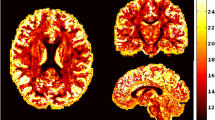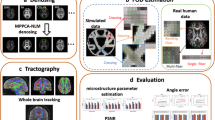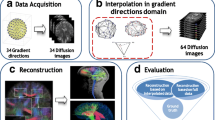Abstract
Tractography based on diffusion weighted imaging (DWI) is one of the tools for mapping the white matter structure of the brain. However, the accuracy of reconstructed fiber on the white matter boundary is constrained by the low resolution of DWI. In order to overcome this defect, we proposed a new DWI tractography algorithm combined with functional magnetic resonance (fMRI). Functional correlation tensor derived from fMRI signal anisotropy in the white matter was employed to describe the functional information of the fiber bundle firstly. Then the particle filter scheme was used to estimate the optimal directional probability distribution and reconstruct streamlines. Experiments on in-vivo data showed the fiber pathways under specific functions loading can be effectively reconstructed, and the accuracy of boundary region can be improved.
Similar content being viewed by others
Keywords
1 Introduction
DWI is the primary imaging method for non-invasive study of living brain tissue structures. The direction of fibers in white matter is indirectly estimated by measuring the diffusion of water molecules, with which the tractography algorithm map white matter trajectories [1].
Existing fiber tracking methods can be divided into two categories: deterministic fiber tracking methods and probabilistic fiber tracking methods [2]. The deterministic fiber tracking method starts from seed points and go forward following the diffusion direction distribution at each step. Then it repeats the process until the termination condition is satisfied. The probabilistic fiber tracking method mainly uses the prior information of the fiber to obtain the posterior probability distribution. The direction of each step is sampled from the probability distribution, and the probabilistic path from the seed point to the target area is finally obtained. Describe multiple possible paths in a probabilistic manner to overcome the difficulty of deterministic tracking for complex structure.
Compared to standard anatomical MRI images, dMRI has a lower spatial resolution because of the limited scanning time [3]. Partial Volume Effects (PVE) and angular discretization effects [4] caused by poor spatial resolution reduce fiber reconstructed accuracy in the boundary region. Moreover, the DWI signal decays rapidly in the junction area of white matter and gray matter (GM), which caused most of the fibers stop prematurely in the white matter without reaching the GM. Due to the uncertainly result, the structure and function of fibers in the cerebral gyrus cannot be comprehensive analyzed [5,6,7,8]. To this end, St-Onge, Yeh, and MI-Brain have conducted a series of studies based on the nerve fiber [9, 10].
fMRI is an imaging technique that estimates the functional property of the brain by measuring the blood oxygen level dependent (BOLD) in neuronal functional activity [11]. Previous studies of functional magnetic resonance imaging have been limited to gray matter. However, growing studies have found the BOLD signal in the white matter also contains cranial nerve activity, and the correlation between the neighborhood voxel signals is directional [2]. In addition, specific gray matter cortex and white matter nerve pathways are also associated with brain activity [12], which provides a new way to solve the reconstruction problem in boundary region.
Aiming at the problem of fiber reconstruction accuracy in the boundary region between white matter and gray matter, we propose a novel tractography algorithm using DWI and fMRI of white matter together. The function and structure information of WM were combined by particle filter fiber tracking frame to obtain more precise fiber distribution in the boundary region.
2 Methods
This paper assumes that the fiber trajectory has a Markov property, and each step depends only on the previous step and the current observation data. The observed value is the DWI signal of \( \Omega \; \subset \;{\mathbb{R}}^{3} \) in the three-dimensional space of the brain. The fiber trajectory model consists of a series of displacement vectors in \( \Omega \), where the displacement vector is the parameter to be estimated. Assuming that the intensity of the DWI is \( U \), given the position \( x \in\Omega \), \( v_{k} \) is the unit direction vector in step \( k \). In dynamic systems, states and observations are represented by \( y_{k} = \{ x_{k} ,v_{k} \} \) and \( z_{k} = \{ U_{xk} \} \), and dynamic systems are defined by three densities: initialization, a priori, and maximum likelihood functions [13].
In step k, assume that the current step and the next step are independent of each other:
Due to the fiber trajectory given by (1) and the Markov [14] property of the independent condition, the fiber path can be modeled by a Markov chain. Therefore, dynamic systems are described only by the following densities:
Considering Eqs. (1), (2) and (3) and applying Bayes’ theorem, we can get an expression of posterior density:
The prior probability density reflects the proximity of the current tracking direction to the tracking direction of the previous step. The larger the value, the closer the two tracking directions are, and the further the deviation is. In this paper, the functional ODF constructed from the white matter fMRI signal is selected as the prior probability density function \( p(y_{k} \left| {y_{k - 1} } \right.) \).
Due to the influence of noise and other factors, there are uncertain components in the MRI dispersion information, and the observation probability density \( p(z_{k} \left| {v_{k} } \right.) \) is an indicator to measure such uncertainty. This paper chooses to use the Q-ball model to calculate fODF as the observed probability density \( p(z_{k} \left| {v_{k} } \right.) \).
The posterior probability density function (c) in white matter and gray matter has an example of a fiber cross voxel, which is defined as the product of the prior probability density (a) and the observed probability density function (b), as shown in Fig. 1.
In 3D space, choose vMF distribution as the optimal importance density \( p(y_{0:k - 1} \left| {z_{1:k - 1} } \right.) \).
Particle filtering sequentially samples a set of \( M \) paths starting from the starting point \( x_{0} \in\Omega \). At step \( k = 0 \), the \( M \) weighted particles are tracked forward from \( x_{0} \). Given the set of particles \( \{ y_{0:k}^{(m)} ,w_{k}^{(m)} \}_{m - 1}^{M} \) at step \( k \), the process of propagation to the next step \( k + 1 \) is performed in three phases: prediction, weighting, and selection.
In the prediction phase, since the posterior probability \( p(y_{0:k} \left| {z_{1:k} } \right.) \) cannot be evaluated, the importance density \( \pi (y_{0:k} \left| {z_{1:k} } \right.) \) (which is an approximation of the posterior density) is used to simulate the vector at each point in the fiber path. Assuming the causal relationship of importance density, that is, for all \( t \ge k,\pi (y_{0:k} \left| {z_{1:t} } \right.)\, = \,\pi (y_{0:k} \left| {z_{1:k} } \right.) \), you can choose a recursive formula along the path [10] such as:
Therefore, in step \( k \), the state \( y_{k} \) of the path \( y_{0:k - 1} \) is sampled according to \( \pi (y_{k} \left| {y_{0:k - 1} } \right.,z_{1:k} ) \), taking into account the Markov property of the fiber path.
After the prediction phase, an estimate of the approximate reliability of the posterior density [15] is weighted. Using the ratio between the unknown posterior distribution and its approximation, the weight of the particle is calculated by:
Taking Eqs. (4) and (6) into Eq. (7), we get a recursive definition of particle weights:
Here, the weight \( w_{k}^{(m)} \) in the step \( k \) is calculated using the weight \( w_{{k{ - }1}}^{(m)} \), the prior density \( p(y_{k}^{(m)} \left| {y_{k - 1}^{(m)} } \right.) \), the likelihood density \( p(z_{k} \left| {y_{k}^{(m)} } \right.) \), and the importance density \( \pi (y_{k}^{(m)} \left| {y_{{_{0:k - 1} }}^{(m)} ,z_{1:k} } \right.) \) at the step \( k{ - }1 \). Then standardize:
The importance distribution of Eq. (6) will increase the variance of weights over time [16]. Therefore, in the early stages of the estimation process, a significant portion of the weight may drop rapidly. The purpose of the final phase selection is to avoid this degradation. Estimate the path using an estimate of the effective sample size (ESS) [16, 17]:
When reduced below a fixed threshold, resampling should be performed to eliminate particles with lower weights [2].
3 Experimental Results
The test data collected functional images of visual stimuli from four adults. Visual stimuli were performed with an 8 Hz scintillation plate. The experiment was designed in the form of a square wave, with a 30 s fixed blank screen and then a 30 s chessboard flashing with repeated cycles. Acquisition parameters: T2*-weighted (T2* w) gradient echo (GE), echo planar imaging (EPI) The sequence collected three sets of BOLD signals, TR = 3 s, TE = 45 ms, matrix size = 80 × 80, FOV = 240 × 240 mm2, 43-layer and 3 mm layer spacing, 145 volumes, 435 s. Each subject was scanned with the same parameters as above, and data acquisition was done under visual stimulation. At the same time, a single-shot, spin echo EPI sequence is used to collect diffusion weighted images (DWI) data: b = 1000 s/mm2, 32 diffusion-sensitizing directions, TR = 8.5 s, TE = 65 ms, SENSE factor = 3, matrix size = 128 × 128, FOV = 256 × 256 mm2, 68 layer and 2 mm layer spacing.
The collected data were preprocessed using SPM12. The fMRI signal is sequentially subjected to time layer correction, head motion correction, and FWHM = 4 mm Gaussian smoothing. If the head movement is more than 2 mm and the rotation is greater than 2°, the data will be rejected. The smoothed data of all subjects were registered to their respective DWI data spaces with reference to the DWI data of b = 0. The BOLD signal of all voxels is bandpass filtered by 0.01–0.08 Hz. This band contains the frequency of the experimental stimulus waveform (0.016 Hz). The T1w data was subjected to offset correction and segmentation to obtain white matter, gray matter and cerebrospinal fluid, and then jointly registered to the DWI image space with b = 0 DWI as a reference.
To verify the validity of the proposed algorithm, this study was tested on real brain data. The reconstructed structural pathway is traced from the lateral geniculate nucleus (LGN) to the visual radiation area with a step size of 0.5 pixels. If the advance to the target area or the direction changes by more than 90°, the tracking is stopped. Fiber tracking was performed 800 times for each case. The results of the tracking process are shown in Fig. 2. For comparison, tracking results without fMRI and with fMRI are shown in Fig. 2, respectively. The result is shown in Fig. 2 as the T1 image of the 27th layer. Large-area dispersed streamlines appear in the figure, most of which exit the visual radiation area, which may be due to the fact that the diffuse ODF is wider than the a posteriori ODF, resulting in probabilistic tracking that produces a large number of streamlines for all possible paths.
In order to evaluate the effect of adding fMRI on the fiber reconstruction accuracy in the boundary region between white matter and gray matter, fiber tracking experiments were performed on fiber bundles in the boundary region between white matter and gray matter. Figure 3 shows the results of 200 tracking imaging of different real brain data visual radiation areas, with a step size of 0.5 pixels, and stops tracking if it advances to the target area or the direction changes by more than 90°. For comparison, the tracking results without fMRI and with fMRI were shown in Fig. 3, respectively. The background of (a) and (b) is the T1 image of the 35th layer. The red box and the corresponding magnified area show the tracking results of boundary region between white matter and gray matter in the end point of the radiation. Compared with the tracking result without the added function signal, after adding the functional signal, the fiber bundle at the end point of the radiation is closer to boundary region between white matter and gray matter.
Tracking reconstruction results of the radiation end point region: The red box and the corresponding magnified area are the tracking results of boundary region between white matter and gray matter in the radiation end point area. The image on the left has no fMRI and the image on the right has fMRI. (Color figure online)
Figure 4 is a comparison of the results of tracking the fiber in the radioactive area 800 times, with a step size of 0.5 pixels, and if the advancement to the target area or the direction change is greater than 90°, the tracking is stopped. For comparison, the tracking results without fMRI and with fMRI were shown in Fig. 4, respectively. The background of (a) and (b) is the T1 image of the 35th layer, the background of (c) (d) is the T1 image of the 32nd layer. The red box and the corresponding magnified area show the tracking results of boundary region between white matter and gray matter in the middle section of the radiation. Compared with the tracking result without the added function signal, after adding the function signal, the fiber bundle in the middle section of the radiation is closer to boundary region between white matter and gray matter.
Tracking reconstruction results of the mid-radiation area: The red box and the corresponding magnified area show the tracking results of boundary region between white matter and gray matter in the mid-radiation area. The image on the left has no fMRI and the image on the right has fMRI. (Color figure online)
Calculate the average length of the fiber by calculating the sum of the Euclidean distances of each segment, and invalid fibers (fibers that do not reach the gray matter or any ROI region are referred to as ineffective fibers) as a percentage of total fiber, and among the effective fibers, the fibers having a fiber length of 10 mm or more account for the percentage of the effective fibers, under the condition of adding the fMRI signal and not adding the fMRI signal (Table 1).
4 Conclusion
Aiming at the problem of fiber reconstruction accuracy in boundary region between white matter and gray matter, this paper proposes a new DWI fiber tracking imaging algorithm based on fMRI of white matter, and combines particle filter theory to track and reconstruct imaging. This study provides a new way to solve the problem of fiber reconstruction accuracy in boundary region between white matter and gray matter, and can improve the accuracy of fiber tracking in boundary region between white matter and gray matter.
This study conducted a tracking experiment on real brain data. Firstly, the effectiveness of the proposed method is verified by tracking the LGN to the visual radiation area. By comparing the results of different brain data when adding fMRI signal and without adding fMRI signal, the method can effectively reconstruct the structural pathway from the lateral geniculate nucleus to the visual radiation area. Next, on different brain data, fiber tracking was performed on the middle and end regions of the radiation visual under the condition of adding the fMRI signal and not adding the fMRI signal. This method can improve the fiber tracking of boundary region between white matter and gray matter. Finally, the effectiveness and accuracy of the method are fully illustrated by analyzing the average fiber length and the ineffective fiber results of the tracking results on each data.
In summary, the method introduces the spatial correlation tensor of the fMRI signal anisotropy in the white matter and indirectly describes the geometrical information of the fiber bundle, which can effectively reconstruct the fiber nerve pathway of specific function and improve the fiber bundle reconstruction accuracy of boundary region between white matter and gray matter.
References
Conturo, T.E., Lor, N.F., Cull, T.S.: Tracking neuronal fiber pathways in the living human brain. Proc. Natl. Acad. Sci. U. S. A. 96(18), 10422–10427 (1999)
Girard, G., Whittingstall, K., Deriche, R.: Towards quantitative connectivity analysis: reducing tractography biases. Neuroimage 98, 266–278 (2014)
Friman, O., Farneback, G., Westin, C.: A Bayesian approach for stochastic white matter tractography. IEEE Trans. Med. Imaging 25(8), 965–978 (2006)
Wu, X.D., Li, Y.B., Lin, Y., Zhou, R.L.: Weighted sparse image classification based on low rank representation. Comput. Mater. Contin. 56(1), 91–105 (2018)
Behrens, T.E.J., Johansen Berg, H., Jbabdi, S.: Probabilistic diffusion tractography with multiple fibre orientations: what can we gain. Neuro Image 34, 144–155 (2007)
Tournier, J.D., Susumu, M., Alexander, L.: Diffusion tensor imaging and beyond. Magn. Reson. Med. 65, 1532–1556 (2011)
Basser, P.J., Pierpaoli, C.: Microstructural and physiological features of tissues elucidated by quantitative-diffusion-tensor MRI. J. Magn. Reson. 213(2), 570–590 (2011)
Jbabdi, S., Heidi, J.B.: Tractography: where do we go from here. Brain Connect. 1, 169–183 (2011)
St-Onge, E., Daducci, A., Girard, G., Descoteaux, M.: Surface-enhanced tractography (SET). NeuroImage 169, 524 (2018)
Rheault, F., Houde, J.C., Descoteaux, M.: Visualization, interaction and tractometry: Dealing with millions of streamlines from diffusion MRI tractography. Front. Neuroinformatics 11, 42 (2017)
Smith, R.E.: Anatomically-constrained tractography: improved diffusion MRI streamlines tractography through effective use of anatomical information. Neuroimage 62, 1924–1938 (2012)
Ding, Z., Xu, R., Stephen, K.: Visualizing functional pathways in the human brain using correlation tensors and magnetic resonance imaging. Magn. Reson. Imaging 34(1), 8–17 (2016)
Wu, X., Yang, Z.P., Bailey, S.: Functional connectivity and activity of white matter in somatosensory pathways under tactile stimulations. NeuroImage 152, 371–380 (2017)
Wang, C.T., Feng, Y., Li, T.Z., Xie, H., Kwon, G.-R.: A new encryption-then-compression scheme on gray images using the Markov random field. Comput. Mater. Contin. 56(1), 107–121 (2018)
Arulampalam, M.S., Maskell, S., Gordon, N., Clapp, T.: A tutorial on particle filters for online nonlinear/non-Gaussian Bayesian tracking. IEEE Trans. Signal Process. 50(2), 174–188 (2002)
Ding, Z.: Detection of synchronous brain activity in white matter tracts at rest and under functional loading. Proc. Natl. Acad. Sci. 115(3), 595–600 (2018)
Doucet, A., Godsill, S., Andrieu, C.: On sequential Monte Carlo sampling methods for Bayesian filtering. Stat. Comput. 10(3), 197–208 (2000)
Acknowledgements
This study is Supported by Sichuan Science and Technology Program 2017RZ0012.
Author information
Authors and Affiliations
Corresponding author
Editor information
Editors and Affiliations
Rights and permissions
Copyright information
© 2019 Springer Nature Switzerland AG
About this paper
Cite this paper
Dong, X., Xiao, D., Yang, Z. (2019). DWI Fiber Tracking with Functional MRI of White Matter. In: Sun, X., Pan, Z., Bertino, E. (eds) Artificial Intelligence and Security. ICAIS 2019. Lecture Notes in Computer Science(), vol 11632. Springer, Cham. https://doi.org/10.1007/978-3-030-24274-9_38
Download citation
DOI: https://doi.org/10.1007/978-3-030-24274-9_38
Published:
Publisher Name: Springer, Cham
Print ISBN: 978-3-030-24273-2
Online ISBN: 978-3-030-24274-9
eBook Packages: Computer ScienceComputer Science (R0)








